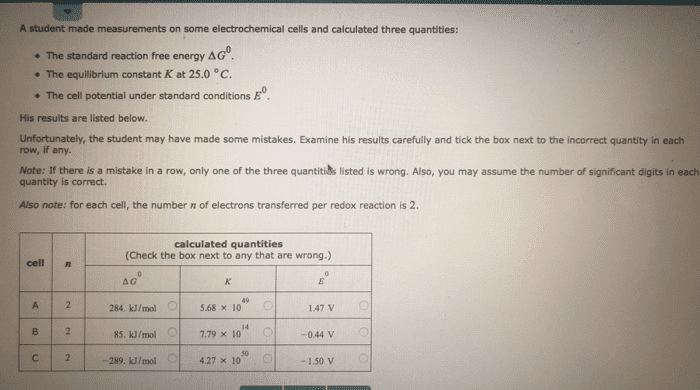. Consider an electrochemical cell for the 2-electron conversion of CO2 to formate (HCOOâ ). Assume that the anode in this cell oxidizes water to O2 and runs at the standard redox potential for this reaction: ! ! O! + 2H! + 2 eâ â H!O �! ° = 1.23 V vs. SHE (1) The standard redox potential for CO2 reduction to formate is: CO! + H!O + 2 eâ â HCOO! + OH! �! ° = â0.23 V vs. SHE (2) However, an electrochemical cell cannot run at this potential because one can only dissolve 0.030M CO2 in water at STP. a. Assuming that a cell is constructed that contains CO2 saturated water and 0.010M formate at pH = 8, what is the minimum potential that will need to be applied to this cell to cause it to produce formate and oxygen at one atmosphere? b. If one mole the electrosynthesized formate is then ignited under standard conditions, what is the value of âH° of combustion, given that the âS° for this reaction is +52.23 J/moleK? c. In addition to formic acid, CO2 can be reduced to formaldehyde (H2CO), methanol and methane. Write out balanced half reactions to determine the number of electrons each transformation involves.
. Consider an electrochemical cell for the 2-electron conversion of CO2 to formate (HCOOâ ). Assume that the anode in this cell oxidizes water to O2 and runs at the standard redox potential for this reaction: ! ! O! + 2H! + 2 eâ â H!O �! ° = 1.23 V vs. SHE (1) The standard redox potential for CO2 reduction to formate is: CO! + H!O + 2 eâ â HCOO! + OH! �! ° = â0.23 V vs. SHE (2) However, an electrochemical cell cannot run at this potential because one can only dissolve 0.030M CO2 in water at STP. a. Assuming that a cell is constructed that contains CO2 saturated water and 0.010M formate at pH = 8, what is the minimum potential that will need to be applied to this cell to cause it to produce formate and oxygen at one atmosphere? b. If one mole the electrosynthesized formate is then ignited under standard conditions, what is the value of âH° of combustion, given that the âS° for this reaction is +52.23 J/moleK? c. In addition to formic acid, CO2 can be reduced to formaldehyde (H2CO), methanol and methane. Write out balanced half reactions to determine the number of electrons each transformation involves.


